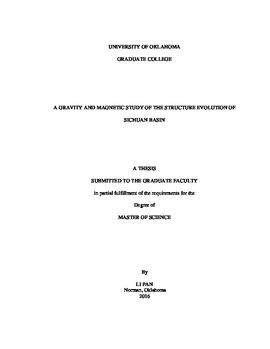| dc.description.abstract | The Sichuan Basin and its adjacent area have attracted increasing research attention during the past decade. Although damaging earthquakes occurred in 2008, the natural gas potential in this region is also remarkable. Therefore, it is important to carry out detailed research on the structure evolution of the Sichuan Basin and how it relates to local hydrocarbon accumulations and possibly earthquake hazards. Previous studies on the tectonic evolution of the region have revealed a complex structure beneath the periphery of Sichuan Basin. In this study, the modern gravity and magnetic data were employed and analyzed, which contributed to the deep tectonic structural interpretation. A significant NW to SE oriented gravity anomaly increase indicates that the crustal thickness decreases from Songpan - Ganzi terrane into the Sichuan Basin. A strong horizontal gravity gradient belt clearly follows the Longmenshan fault-thrust belt. The central paleo-uplift in the Sichuan Basin correlates with high gravity and magnetic anomaly values. The western boundary of the Sichuan Basin exhibits several scattered positive magnetic anomalies, which correlate with Precambrian igneous intrusions. Based on the data from China National Petroleum Company, three seismic reflection profiles were utilized to study the sedimentary characteristics and shallow structural deformation in the Sichuan Basin. According to these seismic profiles, the Longmenshan orogeny and western Sichuan foreland basin subsidence provided the matter-source and accommodation space for the deposition of the Xujiahe Formation in the Late Triassic. Across the area with the best data coverage, an integrated 2-D geologic model is generated by all geological and geophysical controls. The inversion model clearly displays the geometry of crustal structure variations and shallow strata deformations. The central paleo-uplift stands out as gravity high along the model profile. The Northwestern Depression and Southeastern Depression have gentle sedimentary thickness variations, and both attenuate upward toward the paleo-uplift. The Longmenshan fault-thrust belt represents the most complex crustal structure in the area with older formations superposed on younger formations. Large faults are well developed, which make it an earthquake-prone region as well as, a significant unconventional gas reservoir. | en_US |
